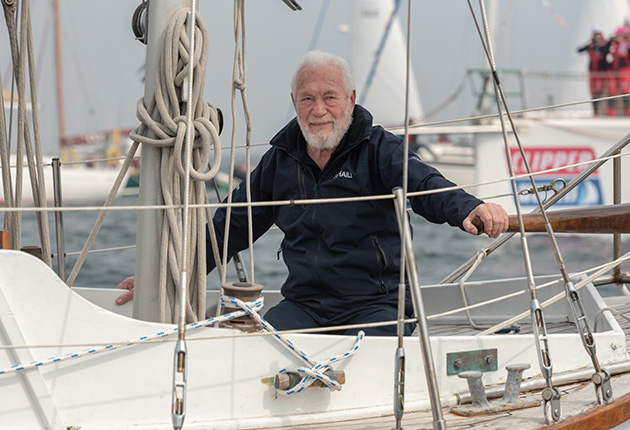Skippers cruising to and from the UK need to prepare now for the ‘bureaucracy of sailing’ post-Brexit, the Cruising Association (CA) has warned
Boat owners are being advised by Her Majesty’s Revenue and Customs (HMRC) to carry evidence of VAT status onboard their vessels ‘at all times’ in case of checks by customs officials.
The details have been published in HMRC Notice 8: sailing your pleasure craft to and from the UK, following the end of the Brexit transition period on 31 December 2020.
The Cruising Association (CA) has warned skippers that they need to prepare now for the ‘bureaucracy of sailing’ post-Brexit.
It is advising owners to put together evidence of VAT status, such as documentation of VAT paid, and evidence of where their yacht was at the end of the transition period, such as a confirmatory letter from a marina and maintenance invoices.
‘They will also need to keep careful records about where their yacht has been subsequently, such as mooring receipts, so there is a record trail of evidence for VAT status in case they are asked by officials,’ stressed Roger Bickerstaff, who sits on the CA’s Regulations and Technical Services (RATS) committee, which is examining the impact of Brexit on cruising.
He added that all documentation should be brought to and from the boat, rather than left onboard, due to the ‘damp nature’ of vessels.
Continues below…
Cruising after Brexit and sailing in Europe
As Europe begins to open up again for cruising, Lu Heikell looks at the implications of Brexit on UK sailors…
Can I buy a boat with no paperwork?
We answer your questions. This month - Can I buy a boat with no paperwork?
How to sail to France from the UK
For home-waters sailors who are considering a holiday cruise to France, Ken Endean looks at the options for making a…
UK Brexit deal: Sir Robin Knox-Johnston backs campaign to change 90 day visa rule
The Cruising Association is campaigning for sailors to be given a 180-day cruising visa for EU countries, rather than being…
Challenge to Brexit deal immigration rule
The Brexit deal only allows UK sailors to cruise the EU for 90 days in every 180-day period. Pilot book…
Initially, HMRC announced that owners of boats which have been in the UK under present ownership and were in the EU at the end of the transition period, could avoid paying a second VAT payment if the vessel returned to the UK before 31 December 2021. This has now been extended until 30 June 2022.
This applies regardless of when the boat left the UK, and only to owners who can’t meet the three year condition of Returned Goods Relief (RGR).
Owners who bought their vessels in the EU that have not been located in the UK during their current ownership will have to pay UK VAT on their boat if they want to bring it back to the UK, even if they have paid EU VAT.
This applies to new and second hand boats.
Bickerstaff said this was ‘really unfair’ to owners of vessels bought in the EU, especially as HMRC had indicated in 2019 that this wouldn’t be the case.

A yacht survey could be useful in helping to prove the age and location of a vessel, if you have no VAT documentation.
The EU has said boats which were in the EU on 31 December 2020 will retain their EU VAT paid status.
Any non-EU vessel from a third country, which the UK now is, may be temporary imported (TI) into the EU territorial waters for up to 18 months without become liable to pay VAT.
Owners may be required to keep a transit log onboard which must be stamped when leaving a country and when entering a new country via a port of entry.
Leaving the EU, such as sailing to non-EU territories like Turkey or Montenegro, and returning to the EU will automatically re-start the 18 month clock.
Proof of leaving includes a marina receipt from a non-EU country or customs documents.
In the UK, HMRC has confirmed to Yachting Monthly that customs checks would apply to all vessels, regardless of size, and documentary evidence would include the original invoice or receipt, evidence that VAT was paid at importation or invoices for material used if owners built their own boat.
For owners who don’t have these documents, HMRC said it ‘may consider alternative evidence, such as a sales invoice or any other documentary evidence, on a case by case basis.’
A registration document on its own does not prove the UK VAT status of the vessel.
HMRC said it can apply civil or criminal penalties to those who fail to account for VAT correctly, but stressed that it was committed to helping customers who need assistance or who make a genuine mistake.
Evidence, such as a receipt of mooring in a UK marina, will also need to be retained to demonstrate the location of the vessel at the end of the transition period.
Marine surveys, insurance documents and receipts for mooring fees or harbour dues would all be useful in helping to prove the age and location of a vessel.
Bickerstaff said in Europe, it was still unclear what documentary evidence would be needed to prove where a vessel was at the end of the Brexit transition period.
The EU Commission has said there are no formal requirements, with individual EU countries determining the documentation required.
This article was updated in March 2021 to reflect the latest announcement of the extension to RGR grace period.
Enjoyed reading this?
You can save money by taking out a subscription to Yachting Monthly magazine.
Subscriptions cost less than the cover price and are available in both print and digital editions through our official online shop Magazines Direct. All postage and delivery costs are included.
Click here to find your nearest shop selling Yachting Monthly
-
- Yachting Monthly is packed with all the information you need to help you get the most from your time on the water.
- Take your seamanship to the next level with tips, advice and skills from our expert skippers and sailors
- Impartial in-depth reviews of the latest yachts and equipment will ensure you buy the best whatever your budget
- If you are looking to cruise away with friends Yachting Monthly will give you plenty of ideas of where to sail and anchor
For all the latest from the sailing world, follow our social media channels Facebook, Twitter and Instagram.









